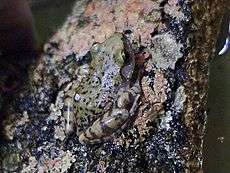Eleutherodactylus marnockii
Eleutherodactylus marnockii, the cliff chirping frog, is a small eleutherodactylid frog found in central and western Texas, the United States, and in Coahuila, northern Mexico.[1][2] It is also known as the cliff frog and Marnock's frog.[2]
| Eleutherodactylus marnockii | |
|---|---|
 | |
| Cliff chirping frog, Eleutherodactylus marnockii | |
| Scientific classification | |
| Kingdom: | Animalia |
| Phylum: | Chordata |
| Class: | Amphibia |
| Order: | Anura |
| Family: | Eleutherodactylidae |
| Genus: | Eleutherodactylus |
| Subgenus: | Syrrhophus |
| Species: | E. marnockii |
| Binomial name | |
| Eleutherodactylus marnockii (Cope, 1878) | |
| Synonyms[2] | |
|
Syrrhophus marnockii Cope, 1878 | |
Description
Adult cliff frogs are 19–38 mm (0.75–1.5 in) in length.They have greenish ground color with brown mottling, often with banding on the rear legs. They have somewhat flattened bodies which allow them to hide in rock crevices.[3]
Behavior and habitat
Cliff chirping frogs are nocturnal and live most of their lives on limestone rock faces.[1][3] Like most frogs, they will hop, but they are also capable of crawling, which aids them in hiding in rock crevices.[3]

Reproduction
Breeding occurs year-round, except at the coldest times of the winter, but generally peaks during the rainy season in April and May. Females can lay up to three clutches of eggs a year, in a moist substrate of leaf litter or soil.[3]
References
- Geoffrey Hammerson (2010). "Eleutherodactylus marnockii". IUCN Red List of Threatened Species. IUCN. 2010: e.T56744A11529774. doi:10.2305/IUCN.UK.2010-2.RLTS.T56744A11529774.en.
- Frost, Darrel R. (2017). "Eleutherodactylus marnockii (Cope, 1878)". Amphibian Species of the World: an Online Reference. Version 6.0. American Museum of Natural History. Retrieved 4 May 2017.
- "Cliff Chirping Frog". Herps of Texas. Retrieved 4 May 2017.
